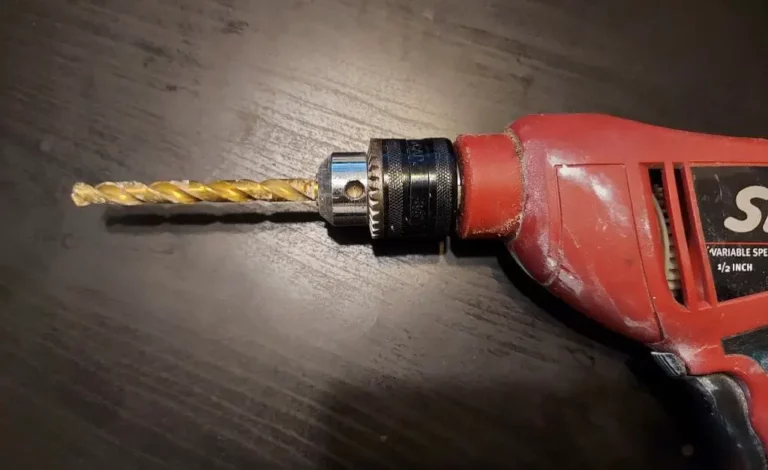Can You Use a Hammer Drill as a Jackhammer?
Hammer drills and jackhammers are specialized tools made for very different purposes. While a hammer drill has some similarities to a jackhammer, they’re not interchangeable.
You can’t use a hammer drill as a jackhammer. Hammer drills, even SDS hammer drills, don’t have the percussive force required for heavy-duty demolition like a jackhammer. Yet, you can use a hammer drill to break apart smaller pieces of concrete, though it’s time-consuming and requires a sledgehammer.
Hammer drills range in speed, force, and capability. Read on to find out what kind of jobs a hammer drill can tackle and when you need to use a more powerful jackhammer.
What Does a Jackhammer Do?
Jackhammer, demolition hammers, and demo hammers are interchangeable terms for an electrically powered or compressed-air powered tool used almost exclusively to break up and tear down masonry. Jackhammers apply only one type of force: an up and down hammer strike.
Industrial Jackhammers
The largest and most powerful jackhammers are the types you see at construction sites and along the highway. They’re tall with t-shaped handlebars, pneumatically or hydraulically powered with a large, flat, chiseled end.
Some models are even pushed around on a cart. This is the tool professionals and road crews use to break up thick masonry and concrete. Still, there are jackhammers on the market at a more modest size and price point for DIYers, like the TR Industrial IS-500 Demolition Jackhammer.
Electric Jackhammers
The electric jackhammer is the style preferred for small and at-home projects. These tools are much lighter, more portable, and considerably less expensive than an industrial jackhammer.
An affordable model like the XtremepowerUS Demolition Jackhammer is a 2200 Watt version that will deliver 1800 impacts per minute. You can watch an electric jackhammer in action in this video:
It isn’t industrial grade, but medium-weight hammers like this will effectively bust through even thick masonry and concrete. They also accept tamping bits, like the Monkey King Bar Hex Tamper Shank and Plate, and can be used to pack dirt and gravel.
What Does a Hammer Drill Do?
A hammer drill has a particular purpose: drilling holes in mortar, brick, concrete, and stone. There are different sizes and styles of hammer drills, and you can even use some of them like mini jackhammers. They can all drill and apply a dual hammering and drilling force.
Cordless Hammer Drill
A cordless hammer drill is a lightweight tool that looks much like a regular power drill. These drills are usually slightly more expensive than a standard drill and have one extra feature: they deliver percussive force as they drill to make holes in masonry.
These cordless hammer drills aren’t high-speed and are suitable for occasional holes and small DIY projects. Some models allow you to use the tool as a regular drill, hammer drill, or driver.
Watch this video to learn how to use a cordless hammer drill:
Corded Hammer Drill
The big difference between the corded and cordless options of a standard hammer drill is power: More BPM, more torque, and longer runtime since it isn’t draining a battery.
This DEWALT Hammer Drill is still in the price range of a power drill or impact driver, and like most hammer drill models, allows you to switch between drilling and hammer drill. These corded models drill holes more easily than cordless hammer drills but still aren’t suitable for larger projects or lots of holes.
You cannot use a standard hammer drill for demolition like a demo hammer. The chucks can’t accept chisel bits or spade bits for demolition, and these tools don’t have a hammer-only function. Their sole purpose is to make holes, not break up masonry or get under tiles and plaster.



Rotary Hammer Drill
This is the hammer drill that can function the most like a jackhammer. A rotary hammer gets its striking force from compressed air and generally has three functions: hammer drill, drill, and hammer-only. Because they’re so much more powerful than a smaller hammer drill, they’re able to handle much bigger jobs that aren’t limited to just drilling holes in masonry and concrete.
Unlike a drill chuck, rotary hammers use SDS drill bits. A slotted drive system (SDS), SDS plus, and SDS Max are square drill bits with slots that lock into a rotary hammer chuck.
Unlike a standard drill bit, where the nose is squeezing the drill bit, the SDS bits are locked into place by the slots. This style bit has the freedom to move up and down in the chuck and allows the rotary hammer to apply much more striking force through the bit. Rotary hammers accept flat, chisel bits for breaking concrete and removing tiles.
For serious projects, something like this DEWALT Rotary Hammer Drill is a better choice than a smaller hammer drill. Rotary hammer drills tend to have much better shock absorption, and the elongated body is easier to hold for more extended periods. If you’re trying to do small-scale demolition like removing tiles and chipping at concrete, this is the only hammer drill that could achieve it.
Is It Okay To Use a Hammer Drill as a Jackhammer?
Jackhammers are much more efficient at breaking concrete apart than a hammer drill. While a hammer drill is precise and accurate, it doesn’t have the power of a jackhammer. Furthermore, the drill bits aren’t big enough to make a hole the same size as a jackhammer would.
Using a hammer drill as a jackhammer rarely works. Both tools have unique applications, making them difficult to substitute for one another. However, you can use a hammer drill to cut through concrete, pavement, and other surfaces if you’re in a bind. Keep in mind that you might need a bigger hammer drill if yours isn’t getting the job done.
Corded drills typically have more power than a cordless variant. They use a direct current from a 12V outlet rather than relying on a wavering battery charge. Below, we’ll discuss how you can break concrete with a hammer drill instead of a jackhammer.
How Do You Break Concrete With a Hammer Drill?
A jackhammer is a specialized tool, rather large and a significant investment. If you don’t have a lot of use for a jackhammer, you may be better off looking for a more economical workaround.
You can use a demo hammer, in which case you can always rent, but in a pinch, or for a smaller area of concrete, you can use a rotary hammer or hammer drill instead. Here’s how:
Prep Your Area
Whenever you’re breaking concrete, whether with a standard hammer drill or a rotary hammer, you need to protect yourself and the area you’re working on.
You should wear hearing protection, safety glasses, work gloves, mask, and close-toed shoes. Concrete can go flying, so cover any windows, glass, and breakable surfaces. Put down a heavy plastic tarp for easy cleanup.
Break Concrete With a Rotary Hammer Drill
The easiest way to get through concrete is with a hammer drill. An SDS hammer drill won’t work quite as well as a jackhammer but can get the job done.
To do this, mount the chisel bit to the rotary hammer. Then, holding the hammer drill at a slight angle, begin chipping away at the concrete. You don’t have to press – the tool will do all the work. Be patient, as breaking concrete with a rotary hammer is a slow process.
Break Concrete With a Hammer Drill
It’s possible to remove bits of concrete with a smaller, non-SDS hammer drill.
Use your hammer drill to create holes along the line you’d like the concrete to break. Then, knock the chunk of concrete loose with a mallet or sledgehammer. However, this method is time-consuming and is only effective in small areas. In addition, it’s hard on your drill and imprecise and hard on your hands.
Other Uses for a Hammer Drill
Your hammer drill can be used like a mini jackhammer on other projects, not just concrete.
Removing Tile
A rotary hammer drill is an excellent tool for fast tile removal. If you don’t plan on saving the tile, a rotary hammer with a chisel bit used on the hammer-only function is a good substitute for a demolition hammer.
If you’re planning on saving your tiles, or you’re not ready to invest in a power tool, you can always pry them up manually. Removing tiles by hand requires just a basic hammer and chisel and, depending on how the tiles are attached, a pry bar.
If you’re a beginner or have never removed tile before, prying them up by hand is safer and easier to learn. Demo hammers and rotary hammer drills can be tricky to get a handle on, and you risk damaging your subflooring if you’re not careful.
Removing Plaster
Getting plaster off walls is a messy and time-consuming job, but you can utilize an SDS hammer drill for speedier removal. Another way to pull up plaster is manually with a simple hammer, crowbar, and flat-blade spade.
To learn how to remove plaster, watch this video:
Final Thoughts
If your demolition job calls for a jackhammer, it’s always best to rent or borrow a tool that can handle your project. Sometimes a rotary hammer can work like a jackhammer if the job is small. Remember, standard hammer drills look much like regular power drills and aren’t useful for demolition. They’re for drilling holes and not much else.
A rotary hammer is your best bet for light demolition. Rotary hammers don’t have the same power as a jackhammer but can handle:
- Breaking small areas of concrete
- Removing tiles
- Removing concrete baseboard
- Loosening rocks
Always refer to the manufacturer’s suggestions.





